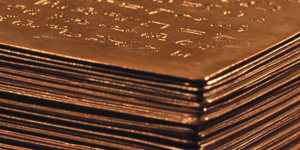You are here
Book of Mormon Central is in the process of migrating to our new Scripture Central website.
We ask for your patience during this transition. Over the coming weeks, all pages of bookofmormoncentral.org will be redirected to their corresponding page on scripturecentral.org, resulting in minimal disruption.

Scripture Block
1 Nephi 16-22
To inspire class members to follow Nephi’s example of faith and willing obedience.
Lesson Manual
KnoWhys
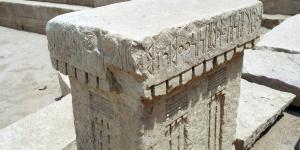
Who Called Ishmael's Burial Place Nahom?
1 Nephi 16:34
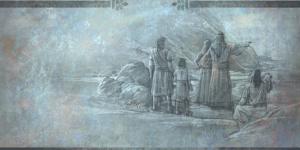
Why Would Nephi Call the Ocean Irreantum
1 Nephi 17:5
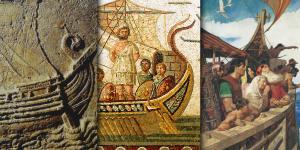
Did Ancient People Sail the Seas?
1 Nephi 18:8
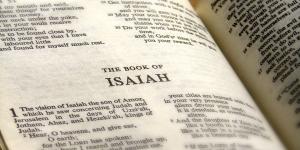
How Might Isaiah 48-49 Be Likened to Lehi's Family?
1 Nephi 19:23
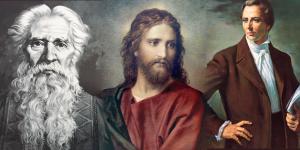
Who is the Servant of Isaiah 49/1 Nephi 21?
1 Nephi 21:3
Articles
The Lord Guides...According to Faith and Diligence
"The 'Perfect Pattern': The Book of Mormon as a Model for the Writing of Sacred History," by Eric C. Olson, BYU Studies, Vol. 31, no. 2
The Nephite Prophets were masterful record keepers. In 1 Nephi 6, 19, and Jacob 1, they write openly about their purposes. This article explains the patterns for historical writing one may find in the Book of Mormon, which leads to a fruitful reflection on what might be a "perfect pattern" for recording personal and church histories in modern times.
"Nephi: An Ideal Teacher of Less-Than-Ideal Students"(link is external) by Tyler J. Griffin, from The Religious Educator(link is external)
Many books and papers have been written on what Nephi experienced as a learner under the tutelage of the Spirit and the angel in 1 Nephi 11–14. Ironically, his experience as a student on the mountaintop was immediately followed by many opportunities for him to become a teacher in the wilderness to his family. Nephi’s interactions with the Spirit and the angel likely served as more than just a vision and discovery of eternal truths; his divine tutelage could also have served as a teacher-training experience. This idea leads us to ask the following questions: (1) What information exists in the chapters immediately following Nephi’s vision that reveals what kind of learners Laman and Lemuel were compared to Nephi? (2) Is there any textual evidence in chapter 15 that Nephi employed the same methods and approaches with his brothers that had been so effectively used on him by his own heavenly tutors? (3) What can we discover about learning and living by comparing and contrasting Nephi and his brothers through their wilderness wanderings in chapter 16? And finally, (4) what implications might these chapters and their principles hold for teachers and students of the gospel in our day?
"What Is Isaiah Doing in First Nephi? Or, How Did Lehi's Family Fare So Far Away from Home?" (link is external)by S. Kent Brown, from From Jerusalem to Zarahemla: Literary and Historical Studies of the Book of Mormon(link is external)
The prophet Nephi incorporated words of Isaiah in his first book for both public and private reasons. Nephi openly declared that he intended to deepen people’s faith in the Holy One of Israel while linking his family’s experiences to prophecies concerning the scattering and gathering of Israel. Evidence in the Book of Mormon points also to the sorrow and estrangement which the family of Lehi and Sariah felt as they fled their home in Jerusalem and traveled across deserts and oceans to the New World. In Isaiah, Nephi found calming solace as well as evidence of prophetic fulfillment.
"The Exodus of Lehi Revisited,"(link is external) by Mark J. Johnson, from Journal of Book of Mormon Studies
To the many studies of what has been called the Exodus Pattern in the Book of Mormon, comparing the exodus of the children of Israel out of Egypt and the exodus made by the Lehites from Jerusalem, I add two additional parallels. The first deals with the death of Ishmael in the desert and the second with the transfiguration of Nephi (1 Ne. 17).
"Lecture 15: 1 Nephi 17-19, 22,"(link is external) by Hugh Nibley, from Teachings of the Book of Mormon, Semester 1(link is external)
In 1 Nephi 17:42 we learn that Lehi's family was "led forth by [God's} matchless power into the land of promise." Throughout this lecture, Hugh Nibley discusses the many ways in which the Lord guided Nephi as he built a ship and led his family toward the promised land.
"Nephi's Bows and Arrows,"(link is external) by William Hamblin, from Reexploring the Book of Mormon(link is external)
Hamblin discusses the symbolic use of Nephi's bow as a political symbol, and also discusses ancient weapon technology. If a bow was replaced, the arrows also had to be replaced to match the specifications of the bow.
"Interview with Warren Aston,"(link is external) by Warren Aston, from Book of Mormon Central(link is external)
On November of this year, Warren Aston sat down with Neal Rappleye for an interview about his life-long study of the Book of Mormon. Warren Aston was the archaeologist of Nahom, the purported place where Ishmael was buried.
"Ishmael,"(link is external) by Christine Purves Baker, from Encyclopedia of Mormonism, (link is external)Volume 2
Biographical entry on what is known of the Book of Mormon figure Ishmael.
"A History of Nahom,"(link is external) by Warren Aston, from BYU Studies, Vol. 51, no. 2(link is external)
Around 700 BC, a wealthy man in southern Arabia donated three limestone altars to a temple dedicated to Ilmaqah, the moon god. Inscribed on each altar was a text identifying him as the grandson of Naw'um of the Nihm tribe. The three altars were unearthed in 1988 by German archaeologists amid the ruins of the Bar'an temple near Marib, in modern Yemen. They provide the earliest known reference to the Nihm, who today, nearly three millennia later, retain the name and are one of Yemen's largest tribes.
"Book of Mormon Minimalists and the NHM Inscriptions: A Response to Dan Vogel,"(link is external) by Neal Rappleye and Stephen O. Smoot, fromInterpreter: A Journal of Mormon Scripture(link is external)
Biblical “minimalists” have sought to undermine or de-emphasize the significance of the Tel Dan inscription attesting to the existence of the “house of David.” Similarly, those who might be called Book of Mormon “minimalists” such as Dan Vogel have marshaled evidence to try to make the nhm inscriptions from south Arabia, corresponding to the Book of Mormon Nahom, seem as irrelevant as possible. Rappleye and Smoot show why the nhm inscriptions still stand as impressive evidence for the historicity of the Book of Mormon.
"Some Notes on Book of Mormon Names,"(link is external) by Stephen D. Ricks, from Interpreter: A Journal of Mormon Scripture(link is external)
This study considers the Book of Mormon personal names Josh, Nahom, and Alma as test cases for the Book of Mormon as an historically authentic ancient document.
"Lehi's Trail and Nahom Revisited," (link is external)by Warren Aston, Michaela J. Aston, Stephen D. Ricks, and John W. Welch, from Reexploring the Book of Mormon(link is external)
This piece discusses the etymology and ethnic origin of the NHM inscription discovered in southern Arabia in order to corroborate the historicity of the Book of Mormon.
"Journey of Faith,"(link is external) by S. Kent Brown and Peter Johnson, YouTube video
"Ishmael and Nahom,"(link is external) by Jody Livingston, original artwork
"What's in a Name?"(link is external) by Paul Y. Hosskisson, from Journal of Book of Mormon Studies(link is external)
This article dissects the Book of Mormon term Irreantum and delves into its linguistic characteristics to determine whether the term could have originated from Hebrew, Egyptian, ancient South Semitic, or another language.
"Ancient Voyages Across the Ocean to America: From 'Impossible' to 'Certain',"(link is external) by John Sorenson, from Journal of Book of Mormon Studies(link is external)
In the past, experts have assumed that primitive sailors would have found it impossible to cross the oceans between the Old World and the New. However, John Sorenson here concludes that the evidence for transoceanic contacts now drowns out the arguments of those who have seen the New World as an isolated island until ad 1492.
"Did Lehi Land in Chile?"(link is external) by Frederick G. Williams, from Reexploring the Book of Mormon(link is external)
Even in early Church history, individuals sought to discover where the Book of Mormon took place geographically. As one of the earliest attempts at Book of Mormon geography, Frederick G. Williams proposes Chile as a possible location for Lehi's disembarkation.
"Before Columbus: The Question of Early Transoceanic Interinfluences,"(link is external) by Stephen C. Jett, from BYU Studies, Vol. 33, no.2(link is external)
This article notes that because of all the striking similarities between the New and Old Worlds, these similarities must have developed either independently, or arouse out of transoceanic contact. Jett explores the possibility that the Old and New worlds could have very well collided before 1492 through water passage.
"Ancient Europeans in America?"(link is external) by John Sorenson, from Reexploring the Book of Mormon(link is external)
This article treats several examples in the New World of Old World influences and seeks to provide evidence of transoceanic contact before Columbus.
"Winds and Currents: A Look at Nephi's Ocean Crossing,"(link is external) by John Sorenson, from Reexploring the Book of Mormon(link is external)
This article uses modern weather patterns and geographical analysis to provide possibilities for the sea route Lehi may have taken. The article first discusses the possibility of Lehi crossing from Arabia through the Indian Sea to Indonesia. Sorenson then discusses a possible route across the Pacific ocean. Sorenson also discusses voyage length and concludes that the voyage could have been completed in a little less than half a year.
"New Technology and Ancient Voyages,"(link is external) by John Sorenson, from Pressing Forward with the Book of Mormon(link is external)
Through radiocarbon dating and DNA analysis, scholars are able to date agricultural trends in Mesoamerica and the New World. While cotton, native only to the Old World, was originally thought to have been brought to the New World by European colonists, radiocarbon dating indicates that cotton was in use in the Old World for several thousand years before that.

